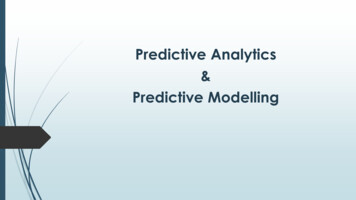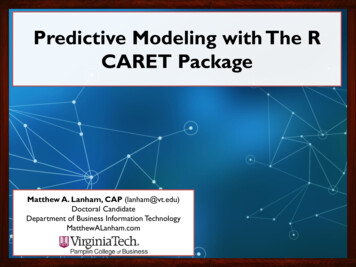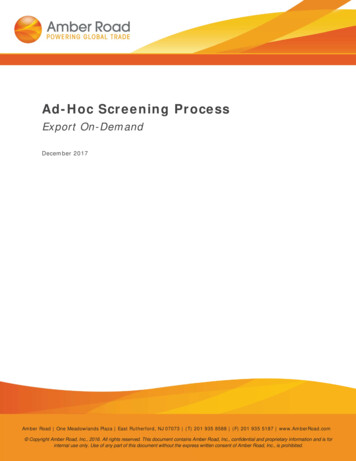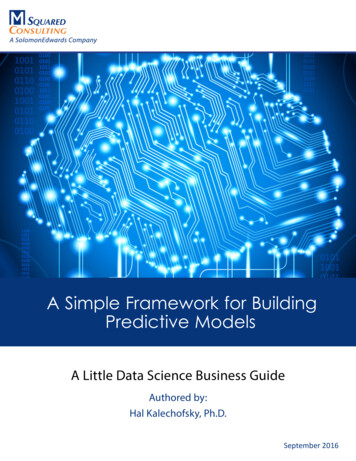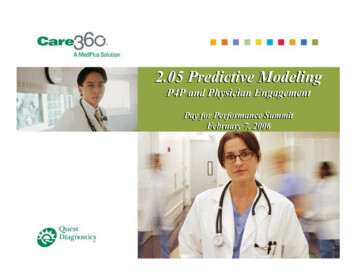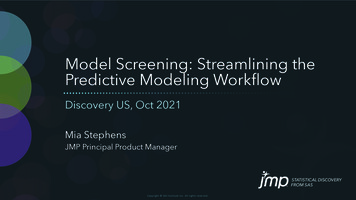
Transcription
Model Screening: Streamlining thePredictive Modeling WorkflowDiscovery US, Oct 2021Mia StephensJMP Principal Product ManagerCo py r i g ht SA S I n sti tu te I n c. A l l r i g hts re se r ve d .
AbstractPredictive modeling is all about finding the model, or combination of models, that mostaccurately predicts the outcome of interest. But, not all problems (and data) are createdequal. For any given scenario, there several possible predictive models you can fit, and,no one type of model works best for all problems. In some cases, a regression modelmight be the top performer, in others it might be a tree-based model or a neuralnetwork.In the search for the best performing model, you might fit all of the available models,one at a time, using cross-validation. Then, you might save the individual models to thedata table, or to the Formula Depot, and then use Model Comparison to compare theperformance of the models on the validation set to select the best one. Now, with thenew Model Screening platform in JMP Pro 16, this workflow has been streamlined. In thistalk, you’ll learn how to use Model Screening to simultaneously fit, validate, compare,explore, select and then deploy the best performing predictive model.Copyr igh t S A S In s titu te In c. A ll r igh ts res er ved.
Outline What is predictive modeling? Types of models can we build The predictive modeling workflowUsing Model Screening to streamline Metrics for comparing model performance ExamplesCopyr igh t S A S In s titu te In c. A ll r igh ts res er ved.
What is Predictive Modeling?Explanatory ModelingPredictive Modeling Y f(X’s) Identify important variables. Example: X1, X3, and X6 arepotential causes of variation in Y.Understand how Y changes, onaverage, as a function of theX’s. Example: A 1 unit change in X isassociated with a 5 unit changein Y. Accurately predict or classifyfuture outcomes. Fit and compare many models. Advanced techniques, not easyto interpret. Overfitting can be a problem. Use validation for modelcomparison and to protectagainst over- and under-fitting.Copyr igh t S A S In s titu te In c. A ll r igh ts res er ved.
Types of Predictive Models Linear and Logistic RegressionGeneralized Linear ModelsPenalized RegressionNeural NetworksClassification and Regression TreesBootstrap Forests and Boosted TreeskNNNaïve BayesSupport Vector MachinesDiscriminantPartial Least Squares*Not an exhaustive listCopyr igh t S A S In s titu te In c. A ll r igh ts res er ved.Fit ModelPredictive ModelingMultivariate Methods
Types of Predictive Models Linear and Logistic RegressionGeneralized Linear ModelsPenalized RegressionNeural NetworksClassification and Regression TreesBootstrap Forests and Boosted TreeskNNNaïve BayesSupport Vector MachinesDiscriminantPartial Least Squares*Not an exhaustive listCopyr igh t S A S In s titu te In c. A ll r igh ts res er ved.Why so manymodels?No single type ofmodel is always thebest.
Analytic WorkflowPredictive ModelingDefine thebusiness problemCompile Data Fit a model with validation Save prediction formula todata table (or publish toFormula Depot)Fit another model, repeatPrepare/Curate Data Explore and Visualize Data Use Model Comparison toevaluate the performance ofeach model on validation data Choose the best model (orset/combination of models) Deploy the modelAnalyze Data/Build ModelsOrganize Results/FindingsShare Results/CommunicateCopyr igh t S A S In s titu te In c. A ll r igh ts res er ved.
Analytic WorkflowPredictive Modeling (with Model Screening)Compile DataPrepare/Curate DataExplore and Visualize Data Fit the desired models inModel Screening Select the best model(s) Explore the model(s) Deploy the best modelAnalyze Data/Build ModelsOrganize Results/FindingsShare Results/CommunicateCopyr igh t S A S In s titu te In c. A ll r igh ts res er ved.
Example 1: DiabetesScenario: Researchers want to predict rate of disease progressionone year after baseline. Ten baseline variables, age, gender, body mass index, averageblood pressure, and six blood serum measurements n 442 diabetes patients. The response Y is a quantitative measure. The response Y Binary (High/Low)Modeling goal: Predict patients most likely to have a high rate ofdisease progression, so corrective actions can be taken.Efron, B., Hastie, T., Johnstone, J., and Tibshirani, R. (2004).Copyr igh t S A S In s titu te In c. A ll r igh ts res er ved.
Comparing Predictive ModelsHow do you decide which model predicts the best? Compare measures of accuracy on the Validation set (or Test set).For continuous responses:RMSE (or RASE) – lower is better AAE, MAD, MAE – lower is better RSquare – higher is better For categorical responses:Misclassification (or error) and accuracy rates Precision (positive predictive value) AUC, Sensitivity (TP rate, recall), Specificity (TN rate) F1-Score and MCC – good with unbalanced data Copyr igh t S A S In s titu te In c. A ll r igh ts res er ved.
Example 2: Credit Card MarketingScenario: Market research on acceptance of credit card offers.Response: Offer Accepted (Only 5.5% of the offers are accepted)Factors: Reward (Air Miles, Cash Back, Points) Mailer Type (Letter, Post Card) Financial information (Income Level, Credit Rating, ),Modeling goal: Identify customers most likely to accept thecredit card offer.Copyr igh t S A S In s titu te In c. A ll r igh ts res er ved.
Summary Predictive Modeling: Accurately predict or classify future outcomes Fit and compare many models using validationModel Screening streamlines the workflow: Fit models same time, one platform Select dominant model(s) Explore model details, and fit new Use Decision Threshold to explore cutoff for classification Deploy best model to the data table or Formula DepotCopyr igh t S A S In s titu te In c. A ll r igh ts res er ved.
For More InformationClassification Metrics: https://en.wikipedia.org/wiki/Sensitivity and specificityPredictive Modeling, and Model Screening in JMP Pro: JMP User Community Learn JMP STIPS, Module 7 Model Screening BlogJMP Early Adopter Program: See what’s coming in JMP 17 Provide early feedbackCopyr igh t S A S In s titu te In c. A ll r igh ts res er ved.
Thank you!jmp.comCo py r i g ht SA S I n sti tu te I n c. A l l r i g hts re se r ve d .
Why use Validation?An illustration, borrowed from STIPS(The Statistical Thinking for Industrial Problem Solvingfree online course)Co py r i g ht SA S I n sti tu te I n c. A l l r i g hts re se r ve d .
Can we predictY from X?Borrowed from STIPS, Module 7Copyr igh t S A S In s titu te In c. A ll r igh ts res er ved.
Simple linear modeldoesn't make sense.linearCopyr igh t S A S In s titu te In c. A ll r igh ts res er ved.
Quadratic model doesn'tdescribe the relationship.quadraticCopyr igh t S A S In s titu te In c. A ll r igh ts res er ved.
The cubic model doesa much better job!cubicCopyr igh t S A S In s titu te In c. A ll r igh ts res er ved.
If a cubic model is good, ahigher order polynomialmust be better!But do I need a modelwith this muchcomplexity?no prediction error10th-orderpolynomialCopyr igh t S A S In s titu te In c. A ll r igh ts res er ved.
Copyr igh t S A S In s titu te In c. A ll r igh ts res er ved.
0.050.00123456OrderCopyr igh t S A S In s titu te In c. A ll r igh ts res er ved.78910
What is Predictive Modeling? Predictive Modeling Accurately predict or classify future outcomes. Fit and compare many models. Advanced techniques, not easy to interpret. Overfitting can be a problem. Use validation for model comparison and to protect against over-and under-fitting. Explanatory Modeling Y f(X's)


